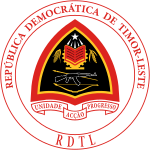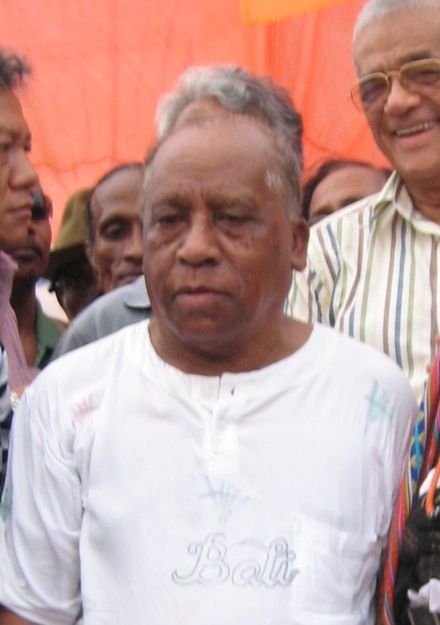Democratic Republic of East Timor (1975)
Democratic Republic of East Timor
| |||||||||
|---|---|---|---|---|---|---|---|---|---|
| 1975–1976 | |||||||||
| Anthem: Pátria (Portuguese) "Fatherland" | |||||||||
 East Timor in South East Asia | |||||||||
| Capital | Dili | ||||||||
| Common languages | Portuguese | ||||||||
| Government | Socialist republic | ||||||||
| President | |||||||||
• 1975 | Francisco Xavier do Amaral | ||||||||
• 1975–1976 | Nicolau dos Reis Lobato | ||||||||
| Prime Minister | |||||||||
• 1975 | Nicolau dos Reis Lobato | ||||||||
| Historical era | Cold War | ||||||||
| 28 November 1975 | |||||||||
| 7 December 1975 | |||||||||
| 17 July 1976 | |||||||||
| Currency | Escudo | ||||||||
| ISO 3166 code | TL | ||||||||
| |||||||||
| History of East Timor |
|---|
 |
| Chronology |
| Topics |
|
|
The Democratic Republic of East Timor (Portuguese: República Democrática de Timor-Leste, Tetum: Repúblika Demokrátika de Timór-Lorosa'e), was a state that was unilaterally proclaimed on the territory of present-day East Timor on 28 November 1975 prior to the Indonesian invasion of East Timor nine days later on 7 December 1975.
History
Declaration of independence
East Timor was colonised by Portugal in the mid-16th century and administered as Portuguese Timor. After the 1974 Carnation Revolution in Portugal, a decolonisation process was initiated which was to have led to the formation of an elected Constituent Assembly in 1976. Three new parties emerged at this time; the Timorese Democratic Union which advocated continued association with Portugal, Fretilin which supported independence and Apodeti who supported integration into Indonesia.[1] In local elections held on 13 March 1975, Fretilin and UDT emerged as the largest parties, having previously formed an alliance to campaign for independence.
On 11 August 1975, the UDT attempted a coup, in a bid to halt the increasing popularity of Fretilin. Portuguese Governor Mário Lemos Pires fled to the offshore island of Atauro, north of the capital, Dili, from where he later attempted to broker an agreement between the two sides.
On 28 November 1975, Fretilin made a unilateral declaration of independence of the Democratic Republic of East Timor with Francisco Xavier do Amaral as president and Nicolau dos Reis Lobato as prime minister. This act was not recognised by either Portugal or Indonesia.[2][3][4]
On 30 November 1975, Fretilin caused a "Constitution of the Democratic Republic of Timor-Leste (RDTL)" to be read out at an inauguration ceremony for Amaral as the newly appointed president.[5]: 53–56 Article 40 of the new constitution provided for the establishment of a Council of Ministers. On 1 December 1975, Fretilin established that body.[5]: 56
Indonesian invasion
In response, on 30 November 1975, Indonesia encouraged leaders of the UDT, Apodeti, and other smaller parties to sign the Balibo Declaration calling for integration of East Timor into Indonesia.[6] On 7 December 1975, Indonesian forces launched a massive air and sea invasion, known as Operasi Seroja (Operation Lotus), citing the potential for a communist government, the need to develop the territory and national and regional security risks as reasons for its actions. Indonesian forces occupied the capital, Dili, within hours of launching the invasion during the Battle of Dili[7][8] and occupied the second largest city, Baucau, on 10 December, with Liquisa and Maubara being occupied in late December.[9]
Subsequent events
On 17 December an Indonesian supported Provisional Government of East Timor (Pemerintah Sementara Timor Timur (PSTT)) was formed which was led by Arnaldo dos Reis Araújo of Apodeti and Lopez da Cruz of the UDT.[10][11] A Regional Popular Assembly was established on 31 May 1976 [12] which subsequently adopted a resolution calling for the formal integration of East Timor into Indonesia.[13] On 17 July 1976, Indonesia formally annexed East Timor as the province of Timor Timur with Arnaldo dos Reis Araújo as its first governor.[14]
The United Nations did not recognise either the Democratic Republic of East Timor, proclaimed by Fretilin, or Indonesian sovereignty over East Timor and instead continued to recognise Portugal as the legal Administering Power as demonstrated by United Nations Security Council Resolution 384. This meant that in terms of international law Portuguese Timor nominally continued to exist. An agreement in 1999 between the governments of Portugal and Indonesia led to a referendum on 30 August 1999 in which a majority of the people of East Timor voted for independence. Following a transitional period of United Nations administration, East Timor became independent as the Democratic Republic of East Timor on 20 May 2002.
Text of the Declaration of Independence
Text
In Portuguese:[15]
Proclamação da República Democrática de Timor Leste
Encarnando a espiração suprema do povo de Timor Leste e para salvaguarda dos
seus mais legítimos direitos e interesses
como Nação Soberana, o Comité Central
da FRENTE REVOLUCIONÁRIA DE TIMOR LESTE
INDEPENDENTE – FRETILIN –
decreta e eu proclamo, unilateralmente,
a Independência de Timor Leste
que passa a ser, a partir das 00H00 de hoje,
a República Democrática de
Timor-Leste, anti-colonialista e anti-imperialista.Viva a República Democrática de Timor Leste !
Viva o Povo de Timor Leste Livre e Independente !
Viva a FRETILIN !
In English:
Proclamation of the Democratic Republic of East Timor
Embodying the supreme aspiration of the people of East Timor and for safeguarding the
their most legitimate rights and interests
as a Sovereign Nation, the Central Committee
of the EAST TIMOR REVOLUTIONARY FRONT
INDEPENDENT – FRETILIN –
decrees and I proclaim, unilaterally,
the Independence of East Timor
which will be, as of 00:00 today,
the Democratic Republic of
Timor-Leste, anti-colonialist and anti-imperialist.Long Live the Democratic Republic of East Timor!
Long Live the People of Free and Independent East Timor!
Long live the FRETILIN!
Government
Following the declaration of independence a Council of Ministers was formed with Francisco Xavier do Amaral as President and Nicolau dos Reis Lobato as Prime Minister.
Presidents
| No. | Portrait | Name (Birth–Death) |
Elected | Term of office | Political party | ||
|---|---|---|---|---|---|---|---|
| Took office | Left office | Time in office | |||||
| 1 | 
|
Francisco Xavier do Amaral (1939–2012) |
— | 28 November 1975 | 7 December 1975 | 9 days | Fretilin |
| 2 | .jpg/440px-Stamp_of_Nicolau_dos_Reis_Lobato_(cropped).jpg)
|
Nicolau dos Reis Lobato (1946–1978) |
7 December 1975 | 31 December 1978 | 3 years, 24 days | Fretilin | |
Prime Minister
| No. | Portrait | Name (Birth–Death) |
Election | Term of office | Political party | ||
|---|---|---|---|---|---|---|---|
| Took office | Left office | Time in office | |||||
| 1 | .jpg/440px-Stamp_of_Nicolau_dos_Reis_Lobato_(cropped).jpg)
|
Nicolau dos Reis Lobato (1946–1978) |
— | 28 November 1975 | 7 December 1975 | 9 days | Fretilin |
International relations
Diplomatic recognition
Following the declaration of independence of the Democratic Republic of East Timor, the state received diplomatic recognition form six mainly socialist states, most of them former Portuguese colonies.
The states that recognised the Democratic Republic of East Timor were as follows:[2][3][4]
Diplomatic representation
The Democratic Republic of East Timor maintained a liaison office in New York located at Apartment 608, 310 East 44th Street.[16]
References
- ^ Ricklefs, M. C. (1991). A History of Modern Indonesia Since c.1300 (2nd ed.). MacMillan. p. 301. ISBN 0-333-57689-6.
- ^ a b "Declaration of Independence". Timor-Leste gov. Archived from the original on 17 December 2021. Retrieved 17 December 2021.
- ^ a b Rourke, Alison (29 August 2019). "East Timor: Indonesia's invasion and the long road to independence". The Guardian. Archived from the original on 5 December 2021. Retrieved 17 December 2021.
- ^ a b Febrian, Ramdan (28 November 2019). Indrawan, Aditya Fajar (ed.). "A Piece Of The Story Of East Timor's Independence From Portugal Then Indonesia Was "annexed"". VOI. Archived from the original on 17 December 2021. Retrieved 17 December 2021.
- ^ a b "Part 3: The History of the Conflict" (PDF). Chega! The Report of the Commission for Reception, Truth, and Reconciliation Timor-Leste. Dili: Commission for Reception, Truth and Reconciliation in East Timor. 2005. Retrieved 12 January 2022 – via East Timor & Indonesia Action Network.
- ^ "Double issue - Volumes 36-37: March 13 - June 26, 1995" (PDF). Documents on East Timor from PeaceNet and Connected Computer Networks. East Timor Action Network. Archived (PDF) from the original on 2022-07-09. Retrieved 2022-09-20.
- ^ "Operasi Linud Terbesar di Dili". Angkasa Online. Archived from the original on 20 February 2008.
- ^ Schwarz (2003), p. 204
- ^ Dunn (1996), pp. 257–60.
- ^ Schwarz (1994), p. 204.; Indonesia (1977), p. 39.
- ^ Taylor (1990), p. 9; Kohen and Taylor, p. 43; Budiardjo and Liong (1984), p. 15 and 96; Nevins, p. 54; Dunn (1996), p. 262; Jolliffe, p. 272. Budiardjo and Liong (1984) call it a "puppet government". Dunn comments: "In fact, the writer was told by Timorese officials who were in Dili at the time that the PGET had no separate existence or powers at all." Jolliffe notes a radio address from Fretilin leader Nicolau Lobato claiming that the PSTT had been sworn in on an Indonesian ship in Dili harbor.
- ^ Indonesia (1977), pp. 43–44.
- ^ Indonesia (1977), p. 44.
- ^ "Integrasi dan Lepasnya Timor Timur dari NKRI". Guru IPS. Archived from the original on 2022-12-06. Retrieved 2023-03-23.
- ^ "05000.264". Archived from the original on 2022-09-24. Retrieved 2022-09-24.
- ^ https://search.archives.un.org/uploads/r/united-nations-archives/5/d/e/5deb4357ccc4cb8edc400fabf3daacf7ce847f0984352a6a2d1adde490cf36f7/S-0443-0126-0002-00005.PDF


